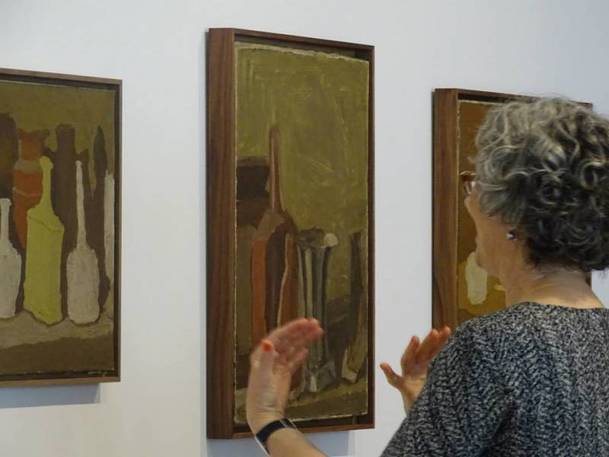


Coming years after the Morandi exhibition I curated at the Metropolitan Museum of Art [2] back in 2008 and the one displayed by the Philip Collection that same year, this is definitely the most remarkable retrospective dedicated to the great Italian artist in recent times.
Moreover, while the first two were organized in a museum, this exhibit takes place in a study and research center, giving visitors the opportunity to really gain insight into the artist and his method of painting.
Furthermore, one of the main goals of CIMA [3] President and Founder Laura Mattioli [4] has been to gather together rarely seen works from private collections—a bold vision indeed.
In my recent interview with her for i-ItalyTV, Mattioli opened up about her intimate relationship with some of Morandi [5]’s masterpieces on display here as well as that of her father, famous Italian art collector Gianni Mattioli (1903-1977).
It is a relationship that is straightforward, emotional and rich in love and complicity. On top of that, the juxtaposition of some paintings from around the 1930s sheds new light on Morandi’s work during that period and highlights certain elements of painting he would take to their extreme in later years.
The Soul’s Breath
The first question we must ask ourselves when facing a painting by Morandi is: “What am I looking at?” or “What should I look at?” We could answer with a metaphor, such as: “Morandi’s paintings are self-contained islands of silence.” As I have written at various times in my essays on Morandi, what matters most in his paintings, and even more so in his drawings, are the blank spaces.
Between the forms that penetrate each other and the forms that we merely intuit lies what I have elsewhere called “the soul’s breath.”
His working room and desk
For Morandi, the still life represented a manner of being; it was a filter through which reality was read, interpreted and sublimated.
He lived and worked in a tiny room containing a simple bed, an old writing desk, a drawing table, a bookcase and, arranged on narrow shelves all around the room, his arsenal of simple objects, discreetly awaiting use, which are familiar to us from his still lifes: bottles, containers, vases, jugs, cooking utensils and boxes.
These things had been unearthed by Morandi from second-hand stores, and the artist loved each and every one, often studying them at night by the light of the moon. Morandi’s working desk was comprised of three shelves.
On the lowest was a jumble of objects that caught his eye. The middle shelf contained objects that appeared as if they were waiting to step onto the stage. On the top shelf, placed at eye- level, were objects selected for particular compositions in all their imperturbable solitude. Then began the director’s subtle weaving of harmonies between the objects. In the vita silente (or “silent life”, a term coined by De Chirico in reference to still lifes), one must listen to, interpretand begin to express the remote voice of objects that invite us to enter into contact with them, penetrating their inexorable materiality.
“Nothing is More Abstract than Reality”
Giorgio Morandi transcends realism and abstraction. Against the background of his love for old things emerge the refined subtleties of modern art. His modernity lies in his switch to abstraction (in the true etymological meaning of the term) and to the methodical search for a reality that is defined by the reiterated form yet whose pictorial essence was obsessively abstract.
In a 1955 interview Morandi declared that “nothing is more abstract than reality.” Although this statement has always been interpreted as a refusal on the part of the artist to make the transition to abstraction, it actually signals his entrance into it. In the same interview, he provides a key to this second interpretation: “I believe that what we see is the creation, the invention of the artist, if he is capable of removing the filters and conventional images that superimpose themselves between the artist and things.” In another interview a couple of years later the artist maintained that: “The sentiments and images inspired by the visible world are very difficult to express and perhaps inexpressible in words, insofar as they are determined precisely by forms, colors, space and light.”
Morandi investigated the free exchange, the oscillation between what appears in the foreground and what appears in the background of the painting. He developed the optical exchange, which was for him so important, in different systems of images.
It is a thrill to return to Morandi’s work after over half a century, and I want to convey my deep admiration for CIMA and its president, as well as everyone who contributed to this insightful exhibition on one of the greatest modern artists from Italy.
* Renato Miracco, currently Cultural Attaché, Embassy of Italy (Washington, DC) is the author of many books and scholarly articles, supervisor curator of all of the Embassy’s exhibits in Washington DC, as well as exhibits curator around the world.
Source URL: http://newsite.iitaly.org/magazine/focus/art-culture/article/morandis-sound-silence
Links
[1] http://newsite.iitaly.org/files/lauramattioli1448515795jpg
[2] http://www.metmuseum.org/
[3] http://www.italianmodernart.org/
[4] http://www.italianmodernart.org/history-of-the-foundation/
[5] https://en.wikipedia.org/wiki/Giorgio_Morandi